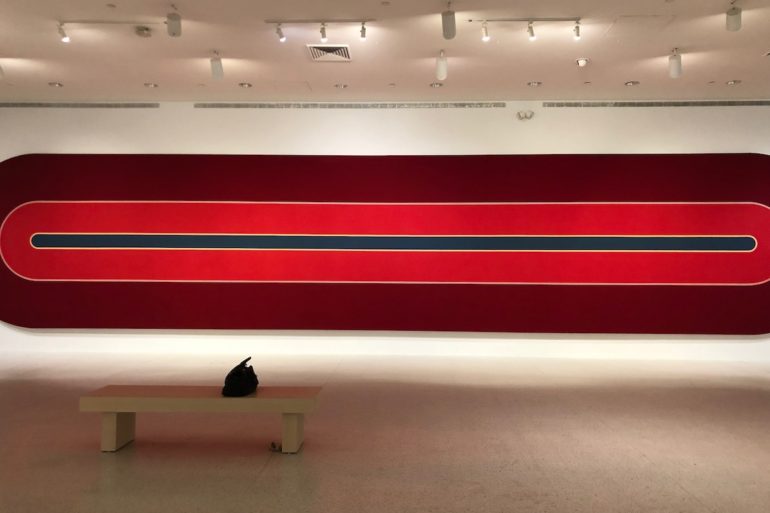
This post is also available in:

The exhibition of Frank Stella, Experiment and Change, at the NSU Art Museum in Fort Lauderdale, which celebrated the 60th anniversary of its foundation, was completed after the 20-day extension to what was initially established.
I think I have visited the exhibition at least twelve times, finding myself thinking of the greatness of this man’s knowledge especially in relation to today’s improvisation, trying to see with his view (after having studied it well) the works, and I found really immense in his artistic journey always looking for that something more that has kept him a step ahead of his time. His work Agua Caliente of 1970, has kept me anchored to the front bench, for so long, as well as Paradoxe sul le Comediene, of the 1974 series Diderot.
The exhibition curated by Bonnie Clearwater, Director and Chief Curator of the museum and presented by AutoNation, has grouped together 300 works from different private collections ranging from works from different career periods.
Not a real retrospective, but the exposure of 60 years of work with consequent variations, not of thought but of knowledge and technique. The works cover a period that starts from the late 50s to the present day, in a constant experiment that led Stella to be considered part of Post Painterly Abstraction minimalism, post-abstract, (term coined by the critic Clement Greenberg for the 1964 exhibition in Los Angeles), to the point of maximalism, with the complex spatial constructions and the works of the Moby Dick series: 135 works each with the title of the chapter related to the book by Herman Melville, at the time abruptly contested by the critics.
In addition to the actual exhibition, an entire wing of the museum was dedicated to preparatory studies with sketches, drawings, plastics and maquette, never before exhibited.
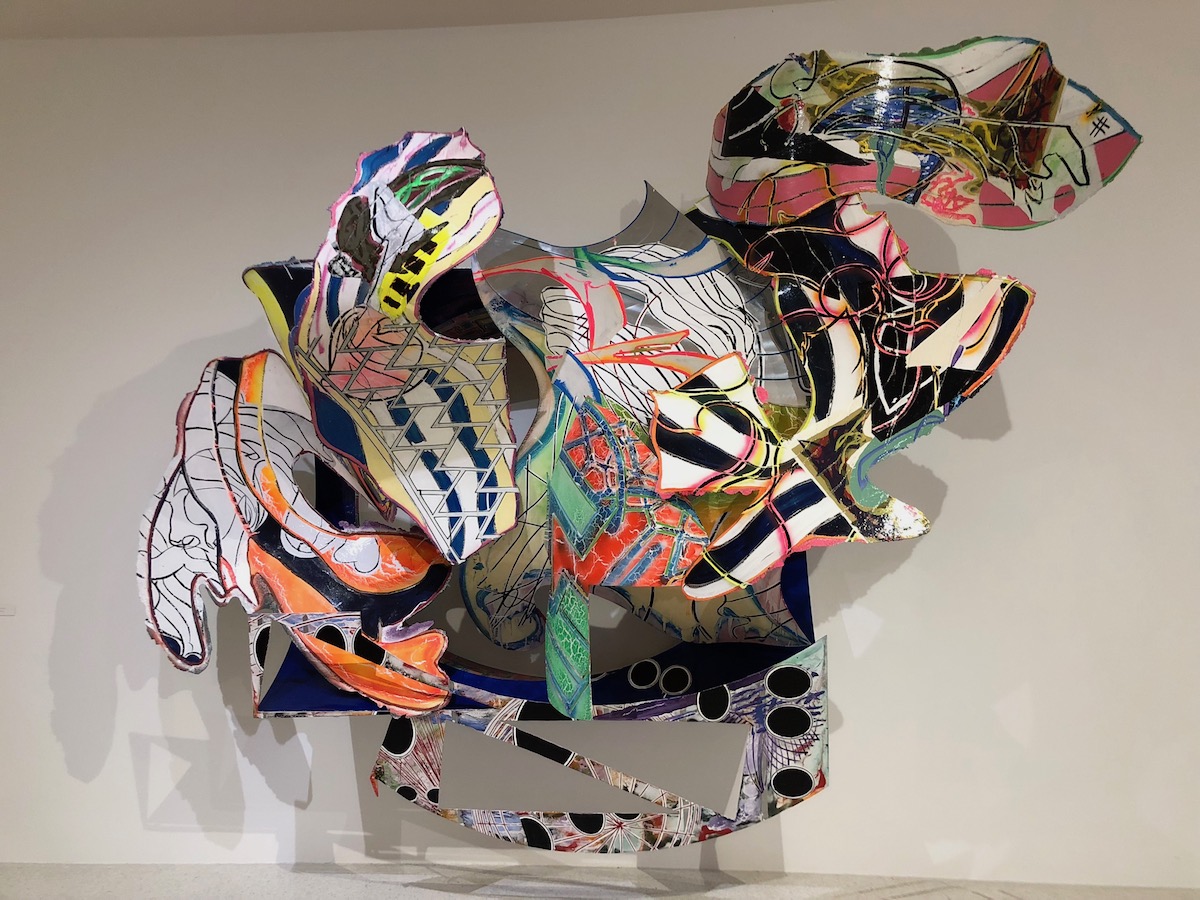
Frank Stella is undoubtedly one of the most interesting, complete and prolific artists of today: he is a painter, sculptor and engraver. He did not limit himself to producing art, but the profound knowledge of the different disciplines, among which the history of art, architecture, geometry and the use of digital technology led him to keep up with the times in terms of design and production techniques – 3D printed models are an example – allowing them to realize large-scale three-dimensional works thus benefiting from a more generous work space, on which he worked using different materials such as fluorescent pigment, fiber carbon and titanium, among many others.
Born in Malden, Massachusetts, in 1936, he graduated from Princeton University in history and painting, then moved to New York, a city considered from a very interesting artistic point of view, given the provocative and wild presence of characters like Pollock, Rothko and de Kooning. In New York, where his studio is still based (from which he commutes back and forth), he reacts to the expressionist ideas of the time in favor of a more rational type of painting, characterized by flat brushstrokes, geometric shapes and bright colors that do not give pictorial illusions or psychological references like the previous painting, but they emphasize the work as an object in itself and no longer as a mere representation of something. Famous is his maxim: What you see is what you see – understood as the rejection of the metaphysical and spiritual approach in reading the work as it always was, in favor of an approach deriving from the spectator’s optical experience given by the lines, the shape, the color and the composition of the work itself.
The art of Jasper Johns, exhibited at the Leo Castelli Gallery (which over time has revolutionized the way of seeing and selling art and that will represent it, in turn, starting from 1960) its flags and the use it makes of encausto, have a strong influence on the art of Stella and is starting from curiosity for the works of Johns who begins to experiment with colored stripes on his own. In 1958, while working in Delta, an emblematic work, in the grip of a burst of anger, he painted the work with the other black and then went to sleep. The following morning, looking at it, he found it exceptionally pleasant because the black bands on the black had simplified it. In 1959 Black Paintings were born, in which regular bands of black paint (Stella usually uses wall paint for his works, departing also in this from the conventional way of conceiving art) are separated by thin bands of unpainted canvas . The striped pattern acts as a system of regulation which, in Stella’s words, forces “the illusionist space out of the painting at a constant rate”. But it was in 1960, thanks to the far-sighted views of Dorothy Miller, MOMA curator, that Stella is recognized for his innovations and before turning twenty-five joins Robert Rauschenberg, Jasper Johns and 13 other new American talents at the Sixteen Americans “. In 1970 he will have the honor of being the youngest artist to have a retrospective at the MOMA in New York, as well as the honor of having a second retrospective, as an artist still alive, at the Whitney Museum in 2015.
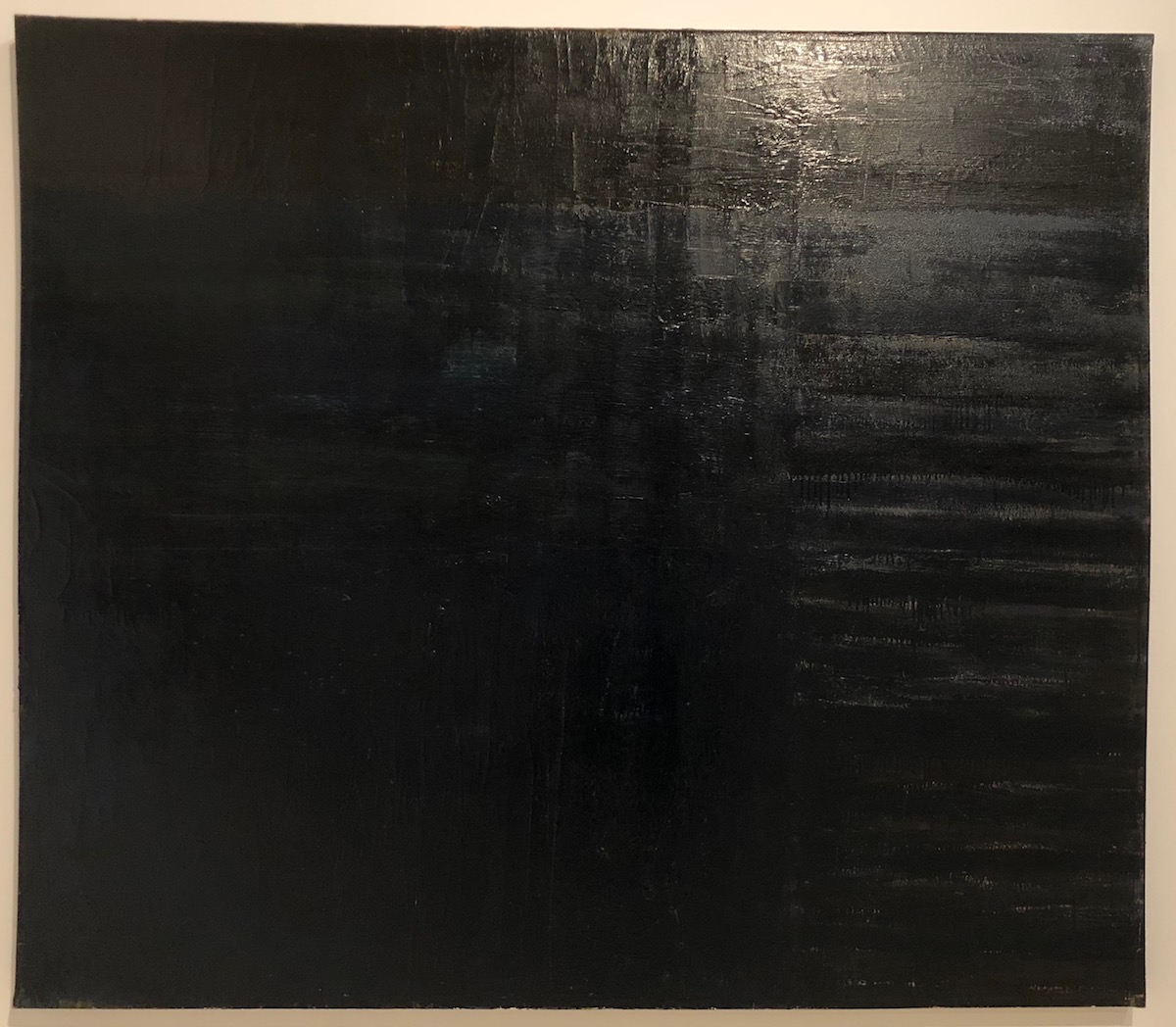
In 1960 he began to produce carved aluminum and copper paintings and works that, in their presentation of regular lines and colors separated by thin gray lines, recall the early Black Painters in a wider range of colors. A fundamental passage in the art of Frank Stella. In 1960 he began to paint with forms of frame that differ from the canonical forms of the square or the rectangle, and referring to the various genres in the history of art, Stella argues that art has always been composed in many forms: an example are the rosettes of cathedrals, rather than the murals, windows or doors that have always broken the regularity of the perimeter of the forms. His paintings thus began to take the form of L, T, O and then in 1966 with irregular polygons they became canvases with irregular geometric shapes characterized by large areas of uninterrupted color. In the even more complex Protractor around the ’70s, Frank Stella in addition to straight edges, introduces the arcs and curves that can be created with a protractor. In his paintings the straight lines provide a stabilizing structure for the curves that break and reform around the breaks of successive shapes. To these basic lines, Stella adds a strong dose of color, also using fluorescent colors, which sometimes might seem risky but on which Stella always maintains control, as he does with the composition of the forms. The protractors are all on a large scale and many of them use the innovative shaped canvases, accentuating the curves and bringing out the works from another perspective, as if they were a combination of painting and sculpture, playing with space and illusion and giving the idea of a three-dimensional piece while keeping the surface completely flat.
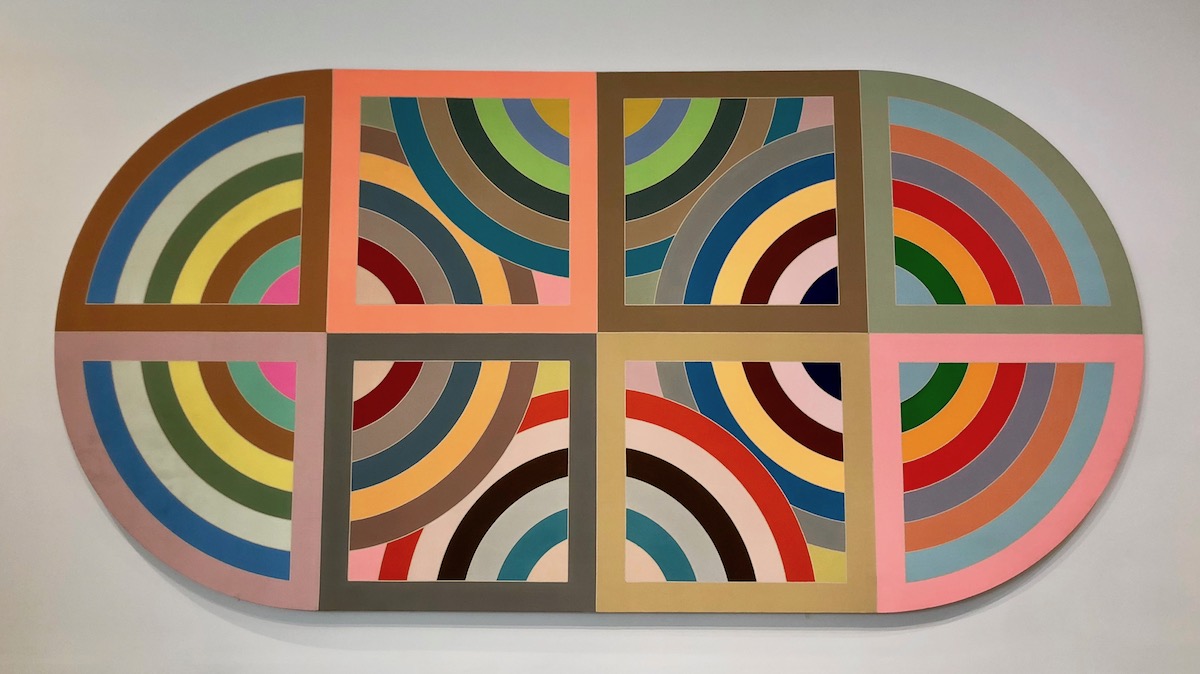
The paintings in this series are named after the ancient Middle Eastern cities from the old circular planes that Stella had visited during his travels and that had caught his attention to the point to be noted.
Toward the end of the 60s, he began producing prints using the printer Kenneth Tyler at Gemini G.E.L. using lithography, screen printing, engraving and lithography off set, or off-set printing, which ensures greater clarity of images. In the ’70s he explored new artistic ways, incorporating collages and reliefs in his paintings as if they were an extension of the layered color bands of his previous works. After the introduction of wood and aluminum, he went from the initial minimalism made of lines and a few colors to curved shapes, fluorescent Day-Glo colors, and almost scribbled brushstrokes.
Based on this interest, Stella elaborates the Exotic Bird and Indian Bird series, presenting an assemblage of painted aluminum shapes that protrude from the wall and reflect its growing interest in three-dimensionality and dynamic textures.
This interest led him to create sculptural works characterized by elaborate intertwining of curves and spirals.
Towards the middle of the 80s he dedicated himself to the maximalist painting so defined for the size of the works so exuberant as to be in striking contrast to the black paintings that had brought him for the first time in the public eye.
The shaped canvases take even less regular shapes and introduce collage elements, for example pieces of canvas glued onto plywood that lead him to create increasingly complex works up to three-dimensional metal objects of large dimensions, which can be considered true sculptures and in view of the size and weight for which the Fort Lauderdale museum itself had to reinforce the walls. Stella considers the sculpture a painting to all effects affirming that: “A sculpture is just a cut-out painting that has risen somewhere”.
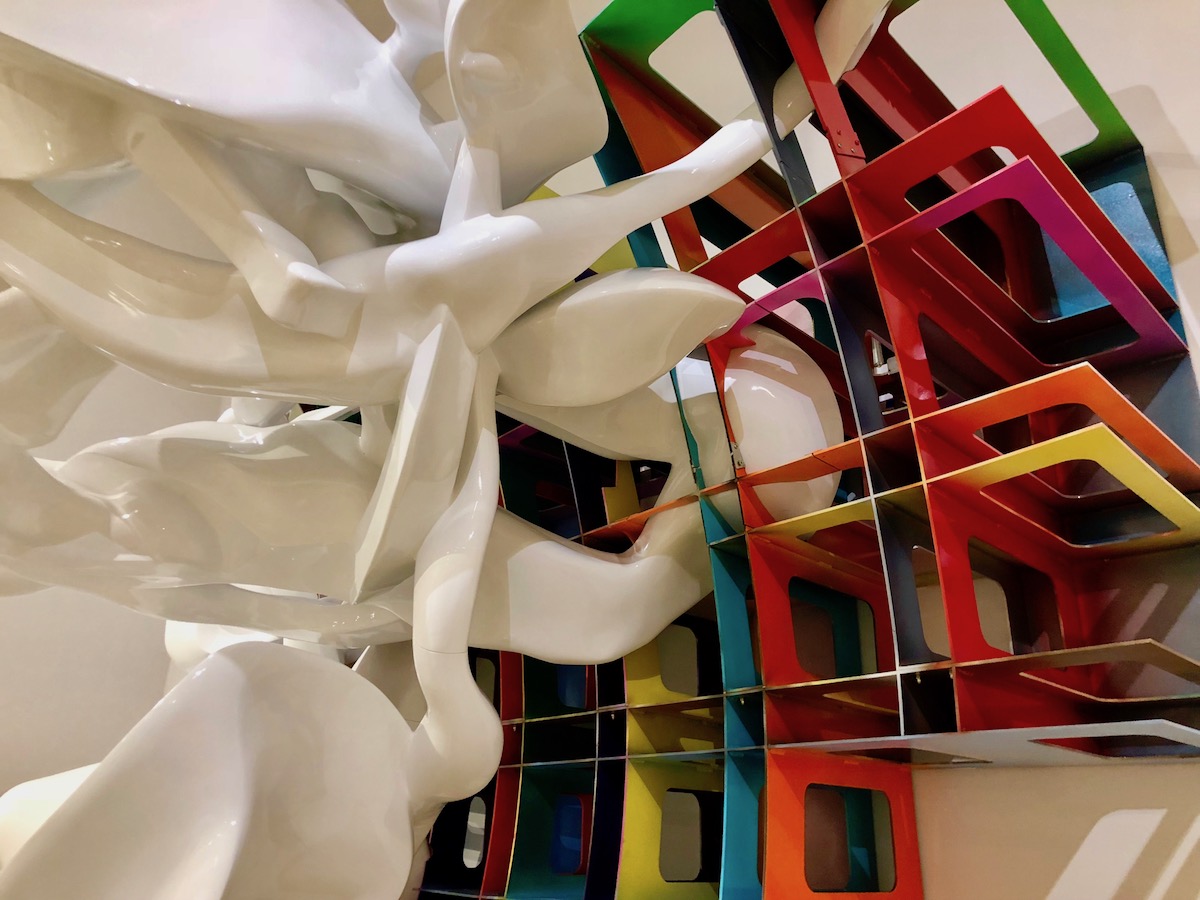
Stella has produced more than 55 series to date for a total of about 3,000 works of art. In addition to numerous awards received including honorary degrees received from Princeton University, Dartmouth College and Brandeis University in Massachusetts, the 2010 National Medal of Arts, received in Washington by President Barack Obama, and the recent Watch Award from World Monuments Founded in 2017, Frank Stella goes beyond the honor of the speeches given at the Pratt Institute in Brooklyn in 1971 and the Working Space writings of the prestigious Charles Eliot Norton chair at Harvard University. In these two prestigious events, Stella talked about the diligent study through the imitation and the research of the intellectual, emotional and illusionist tricks of the great classics of art, among these in particular Caravaggio and Rogier Van Der Weyden, but also Rubens and Velasquez , who had a strong influence on him, and through which he came to the conclusion that even the old masters were artists who made their works by stratification leading him to find his personal concept of art bypassing spatial and methodological problems in painting third dimension.
